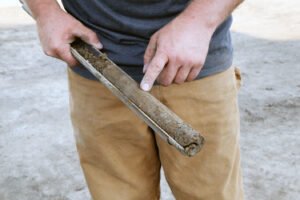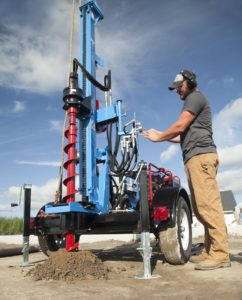Pitfalls that Impact Project Success
 Soil sampling is a crucial first step in everything from construction and mining to agricultural applications. Sampling requires accuracy and attention to detail in order to avoid costly mistakes. Whether testing for soil strength, contaminants or nutrients, avoiding these most common pitfalls are vital to the overall success of the exploration.
Soil sampling is a crucial first step in everything from construction and mining to agricultural applications. Sampling requires accuracy and attention to detail in order to avoid costly mistakes. Whether testing for soil strength, contaminants or nutrients, avoiding these most common pitfalls are vital to the overall success of the exploration.
Incorrect Depth and Sample Size
Testing at the incorrect depth or over too large of an area can provide an inaccurate soil representation as soil nutrient content and strength can vary greatly depending on the depth and location within a site. To ensure accuracy, grid off large sites into more manageable sections that match the specifications of the test order. Next, take multiple samples from each section to compile a thorough soil profile. Pay close attention to the depth at which samples are taken, making sure to match the specs and document the depths.

Ensuring accurate and consistent sample depth can be done manually or with drills capable of automatic options. Manually measuring and marking the depth with each blow or sample can help ensure you’re reaching a consistent specified depth. With manual methods, Little Beaver’s Cathead Kit and weighted hammer are excellent options, especially when sampling in confined spaces. Additionally, drills equipped with an automatic hammer option combine maneuverability and precise depth control into one package, making it easy to access and accurately sample large areas with varying soil types that require multiple samples.
Cross Contamination
Soil cross-contamination is often caused by failing to thoroughly clean equipment between samples, leading to inaccurate readings of the soil. Avoid cross-contamination by wiping down and inspecting the auger and sampling tools between each sample. Equipment selection can also help minimize the risk of contamination. A Hollow Stem Auger allows removal of the center rod and plug for insertion of a soil sampler The auger provides a natural casing inside the hole to keep out surrounding soil that could compromise the sample.
Not Accounting for Site History
Failure to account for the history of a future construction or agricultural site can result in a soil profile that raises more questions than it answers. A site that has largely been left untouched may have more consistent soil attributes than a site that has been home to various construction projects or agricultural applications. This history can greatly impact how land is divided into sampling areas and where higher soil strength or nutrients are more likely to be found. Take out the guesswork by researching before sampling.
Neglecting Site Restoration
Soil sampling often calls for the site to be returned to its original condition once drilling is complete. This can prove to be a time-consuming and costly task if improper sampling equipment is used. Compact equipment can be handy and cause minimal disturbance in adverse weather conditions, hard-to-reach sites and sites with limited rig access. The method used to restore a site will vary depending on the environment. At a minimum, holes must be refilled and compacted, asphalt patched if necessary and the surrounding area cleaned of debris. Consideration should also be taken for buried materials such as pipes and underground cables within the sample area. Leaving the site clean and damage free will protect the contractor’s reputation and lead to increased business opportunities.
The first steps in large construction and agricultural projects can set the tone for years to come, making initial and ongoing soil sampling crucial. Whether testing for soil strength, nutrient content or any other critical aspect to your industry, remember that informed and thorough soil sampling is the foundation on which future successes and savings are built.